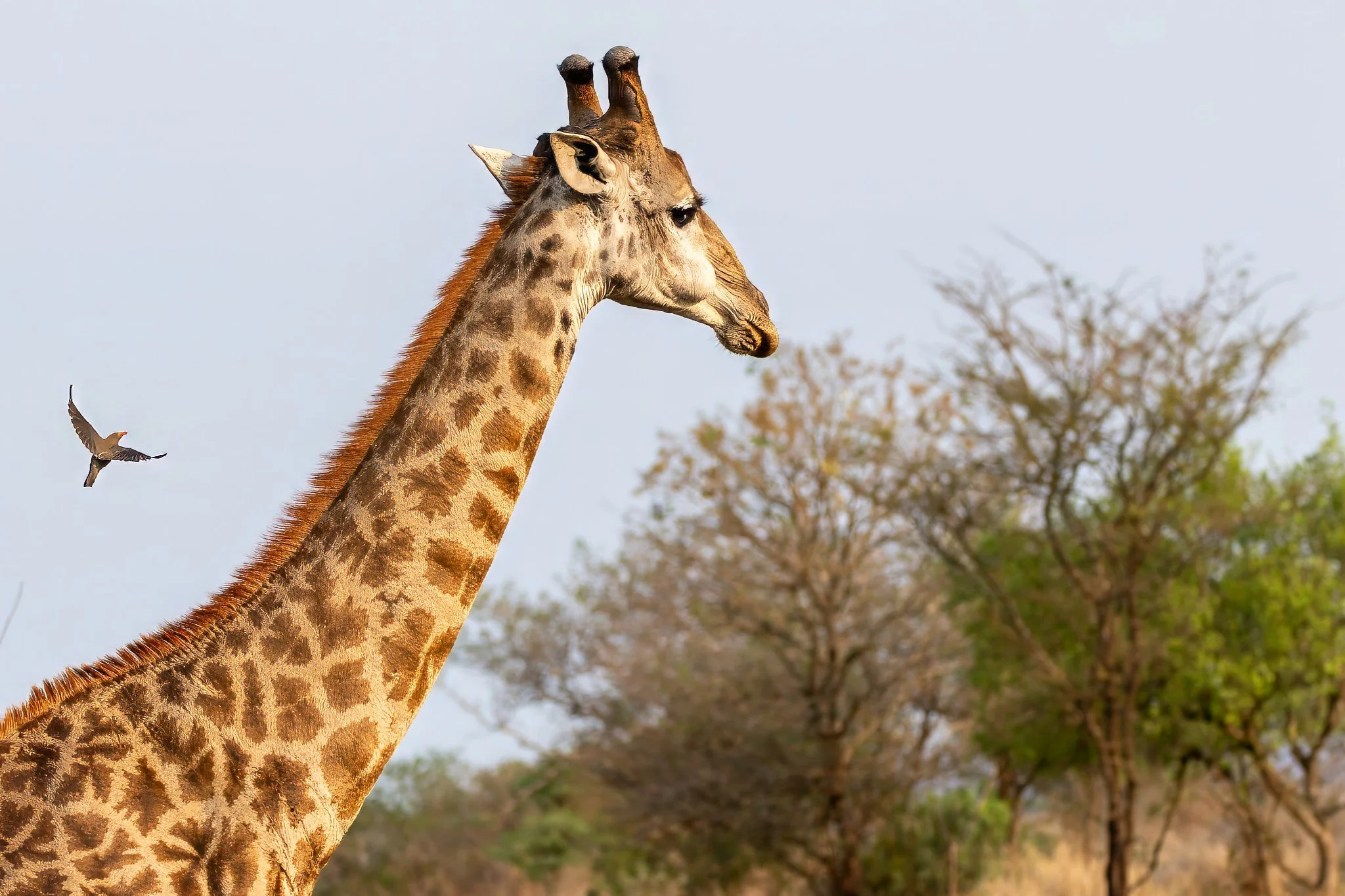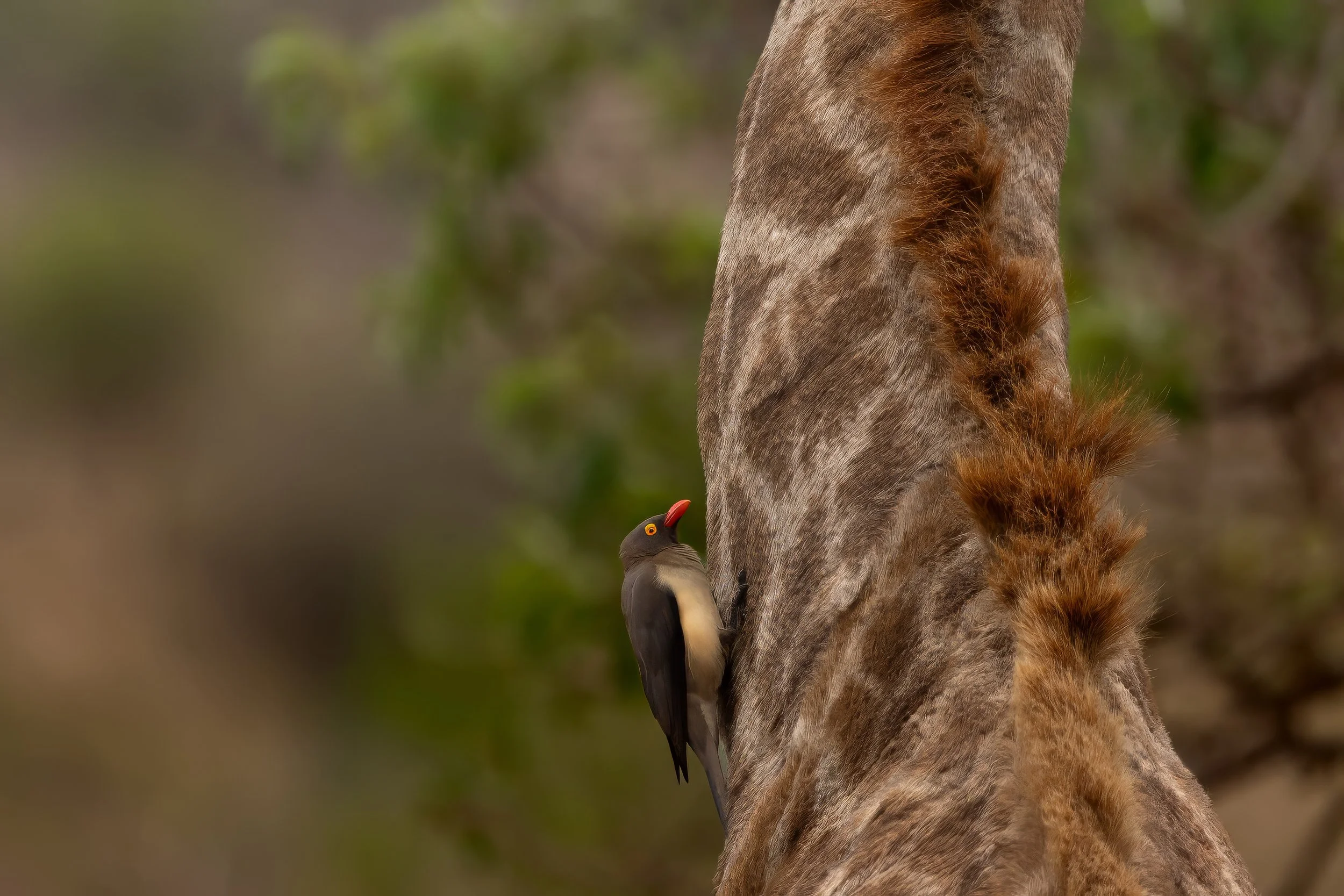The Fascinating Relationship Between Red-Billed Oxpeckers and Giraffes: A Delicate Balance in Nature
While volunteering with Wildlife ACT at Manyoni Private Game Reserve in South Africa, I had the opportunity to capture some incredible moments of red-billed oxpeckers interacting with giraffes, showcasing one of nature’s most intriguing relationships. In the photos, you can see an oxpecker flying up a giraffe's neck and another perched comfortably on its neck—simple snapshots of what seems to be a peaceful and mutually beneficial relationship. But as is often the case in the wild, things aren’t always as they seem.
Adaptations for a Symbiotic Life
Red-billed oxpeckers (Buphagus erythrorhynchus) are birds perfectly adapted for life alongside large mammals. They use their sharp claws to cling onto animals such as giraffes, buffalo, rhinos, and even zebras. Their strong feet allow them to stay perched securely on the uneven surfaces of their hosts, even as these animals move through the bush. Once they’ve settled in, oxpeckers use their specially adapted beaks to pick off parasites like ticks, fleas, and dead skin—providing a valuable service to their host.
This type of relationship is known as mutualism—both the bird and the host animal benefit. The giraffe is rid of irritating parasites, and the oxpecker gets a reliable food source. It’s a win-win, and in most cases, this symbiotic relationship plays a crucial role in helping maintain the health of the animals they perch upon. In fact, some studies suggest that oxpeckers might even help their hosts by alerting them to nearby predators through their behavior and calls.
The Dark Side of the Relationship: From Mutualism to Parasitism
However, as with many things in nature, this seemingly perfect relationship can quickly change. When an animal suffers an injury—whether from a predator like a lion or from a territorial fight—oxpeckers can switch from helpful cleaners to harmful parasites. In these instances, rather than feeding on parasites, the birds may begin feeding on the blood around the wound. They use their sharp beaks to peck at the injury, reopening the wound and preventing it from healing.
This behavior can lead to parasitism, where the oxpecker benefits at the expense of its host. The continuous feeding on an open wound not only delays recovery but can also lead to infection, putting the animal’s health at serious risk. For an already weakened animal, this shift from mutualism to parasitism can be deadly, turning the oxpecker from an ally into a threat.
A Delicate Balance in the Wild
The relationship between oxpeckers and large mammals like giraffes is a fascinating reminder of how fragile the balance of nature can be. One moment, we witness a harmonious interaction that benefits both species; the next, we see how quickly the dynamic can shift to something far more dangerous. This transformation from mutualism to parasitism serves as a powerful example of the complexity of natural relationships.
In the photos captured during my time at Manyoni, you see a snapshot of the oxpecker's role as a helper, delicately feeding on parasites and using its specialized claws to scale the giraffe's neck. But behind that peaceful image is the reality that nature is full of complexities. Even relationships that seem straightforward can shift dramatically, depending on circumstances like injury or illness.
The Importance of Understanding Wildlife Behavior
Understanding the dual nature of relationships like that between red-billed oxpeckers and their hosts is essential for conservationists. By observing these interactions in the field, as I did while volunteering with Wildlife ACT, we gain crucial insights into the health and well-being of the wildlife we work to protect. It reminds us that the dynamics of the animal kingdom are not always black and white but full of nuance and change.
The next time you see an oxpecker perched on the back of a giraffe or buffalo, remember that this small bird plays a much larger role in the complex web of life on the African savanna—sometimes as a friend and, under different circumstances, as a foe.
This experience at Manyoni has deepened my appreciation for the delicate balance of nature, where even the most innocent relationships can shift into something quite unexpected. It’s these moments that make wildlife conservation and photography so thrilling—capturing not just the beauty of the animals, but the intricate, and sometimes harsh, realities of their lives in the wild.


